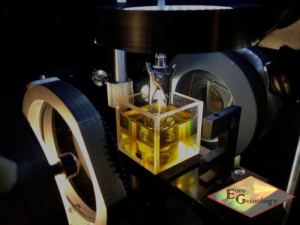The Gem NULLAB 0.001
 One of the most indispensable instrument for a gemologist would be the microscope. Here counts the most important and difficult part of gemology, such as separating natural from synthetic gemstones inclusive of their imitations, artificial products and composites… not to forget opaque gemstones and organic materials such as pearls, coral, ivory etc.
One of the most indispensable instrument for a gemologist would be the microscope. Here counts the most important and difficult part of gemology, such as separating natural from synthetic gemstones inclusive of their imitations, artificial products and composites… not to forget opaque gemstones and organic materials such as pearls, coral, ivory etc.
For a comfortable and diagnostic microscopic research, dark field microscopy showed too many limits. As being used to work in immersion liquids in order to research high RI gemstones without the burden of reflection on the facets, I designed a complete new classic gemological research station. Since my two and a half year old son showed the great interest in gemological microscopy, I decided to name it the Gem NULLAB 0.001. During the construction, I integrated most other classic gemological instruments using the same light source. This allows the station to have a smooth workflow without having to run from one equipment to the other, therefore preventing the loss of time.
After several months of building with my father (Paul Dewit), an expert in metal constructions, the station was finalized. It immediately showed great results with the advantage of the integrated horizontal immersion polariscopy. The Gem NULLAB 0.001 is constructed for continuous usage, made out of solid materials with superb accuracy. Due to its high precision construction, it is really a dream for most gemologists to work on such a station! The current version has everything onboard and is completely mobile. The station itself is under an ongoing process of refining for the next couple of years, as it will gradually be adapted to each need in specific researches.
Functions on the Gem Nullab 0.001
– Gemological refractometer with high precision and easy readings.
– Horizontal and vertical immersion polariscopy with ¼ wave retardation.
– Spectroscopy
– Dichroscope
– Compact density weighing
Analogue and Digital Horizontal Immersion Microscopy
Light Sources:
- Through – Side – On light
- Top ring light (can also be used as dark field illumination)
- External dual fiber optic light
Filters:
- Crossed polarizer’s (With the possibility of dual parallel rotation. By using one singular polarizer it can be used as dichroscope)
- ¼ retardation filter
- Color filters
- Linear and crossed shadowing filters
- Shadow filter to be used with indirect illumination
Digital Ocular
- Inclusion photography
- Digital zoom
- Live digital streaming
- Measurements
Immersion cuvette
Cross Table
UVL and UVS Microscopy










